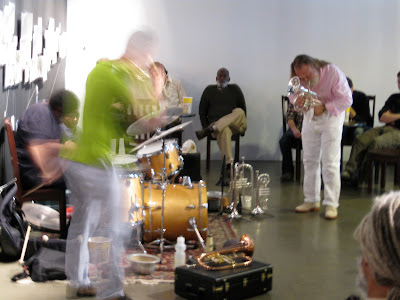Festival Internationale de Musique Actuelle de Victoriaville
Victoriaville, Québec, Canada
May 22, 2010
Festivals can, when at their best, take on the character of community gatherings. This season, FIMAV has felt like this at times. Besides the consistent and clear camaraderie of the ensemble, we have encountered Barre Phillips and his son. Bill had a long chat with Barre and our bassist, Ken Filiano, stuck to him like glue. Last night, I heard my name called in the parking lot. This turned out to be Bruce Gallanter, the owner of
Downtown Music Gallery in Manhattan. Bruce had driven up with a carload of friends and expressed excitement about the music ahead.
This morning Taylor and I met with Bill in his room. Bill completely re-blocked the component sections of the music. "I can't have musicians shuffling through pages of music and not paying attention." We created a new score for the ensemble and set an order for the sections of the new suite. Bill was quick to remind us that any rule/order exists to be broken/changed. He has also chosen to attempt something that he has never done, at least in recent years: rather than play the trumpet, Bill will focus on conducting the ensemble and, at a point, a pre-recorded solo trumpet piece,
Shrike, will be inserted in the middle of the performance.
The ensemble gathered for a short meeting. We distributed the new score, discussed the order and ran through some of the material. I also conducted a playing 'situation' to make some points regarding what we should all be prepared to do later in the day. We then scattered for the afternoon. Some of us had lunch together, went for walks, visited other musicians. I heard at least one hotel room filled with the sound of ardent practice of the new material.

We opted to move the time for soundcheck up to allow us all to make only one trip to the performance venue. We met with Bill on stage, setting sound levels, running aspects of the materials. Bill then launched into his signature story telling mode. For those of us who study the art of leadership, this is something worth attending to. Through these rambling, humorous stories, Bill sets tone, simultaneously knitting all the players together and pulling them into deeply-focused listening as a group. Laughter becomes chorus and we are all in tune with the composer's intent, essence and purpose. And, not for nothing, we are all a bit more relaxed.
As we wait to work, Michel Levasseur, Artistic Director of the festival, stops by to wish us well. It is at this point that we learn of a possible power outage. "If the lights go out, you can just begin again." Yikes! We assure Michel that there will be no 'beginning again' and that, if the power fails, the recording of the concert will be lost.
An hour later we mount the stage. The house is full, and we feel cradled by deep listening from the first notes of the music. Bill cues a duet between Taylor Ho Bynum and Warren Smith on tympani. Spirits enter the room and the music slowly unfolds over the course of an hour. All of us have entered transformed time, and feel as if we have only been busy for twenty minutes when Bill finally draws the music down to silence. The audience breathes for a moment, then rises to their feet in affirmation.
Michel (and, for that matter, all of us!) is excited by the music and vows to bring the recording to market before Christmas.
Images of Bill Dixon & the ensemble by Isabelle Moisan

 We had several days to get to know each other through rehearsal, conversation and, my favorite, shared gourmet meals. My deepest connection was with Franz Koglmann and his wife Ingrid Karl. Franz and Ingrid were longtime friends of Bill Dixon, and presented his work in Vienna at the essential Weiner Musik Galerie many times. Bill was fond of the city and his time there. There are plans afoot to honor Bill's memory in Vienna in the near future.
We had several days to get to know each other through rehearsal, conversation and, my favorite, shared gourmet meals. My deepest connection was with Franz Koglmann and his wife Ingrid Karl. Franz and Ingrid were longtime friends of Bill Dixon, and presented his work in Vienna at the essential Weiner Musik Galerie many times. Bill was fond of the city and his time there. There are plans afoot to honor Bill's memory in Vienna in the near future.














































